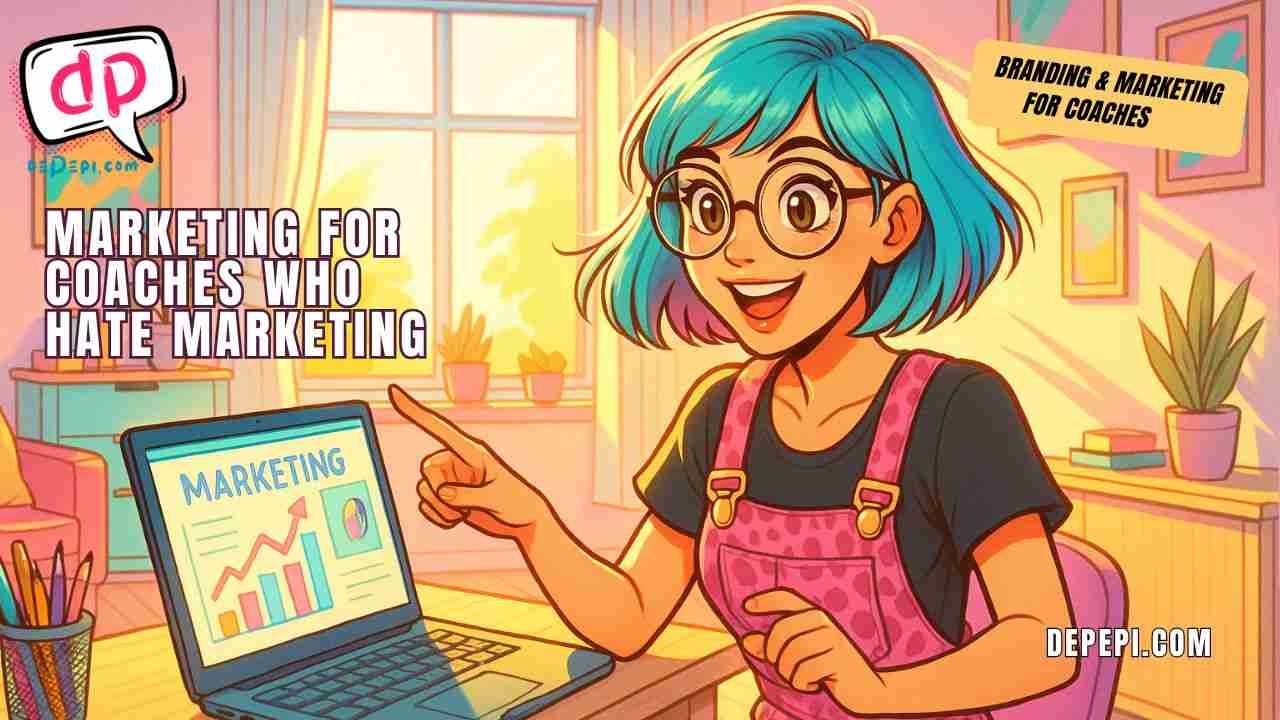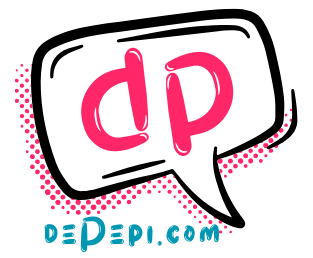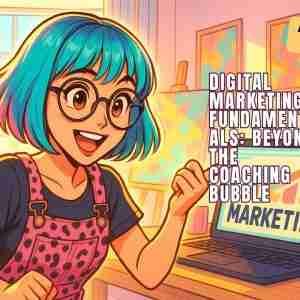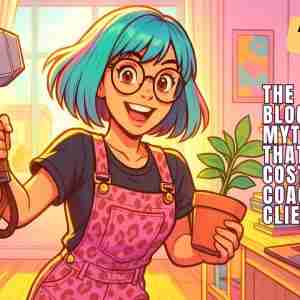Marketing for Coaches Who Hate Marketing

Nowadays, the line between effective branding and strategic marketing has become beautifully blurred. As coaches are not just service providers but transformation facilitators, trust builders, and community creators. Yet, many coaches struggle with the marketing side of their business, often feeling like they’re choosing between authenticity and growth. The truth? You don’t have to choose. Marketing for coaches who hate marketing is possible.
The modern coaching industry requires a nuanced understanding of marketing tactics that respect both the sacred nature of coaching relationships and the practical realities of running a sustainable business.
Marketing for coaches: Understanding Your Ideal Client Avatar
Before diving into tactics and strategies, we must address the cornerstone of all effective marketing: knowing exactly who you’re meant to serve. Your ideal client avatar isn’t just a demographic profile: it’s a deep, empathetic understanding of the person whose life you’re called to transform.
The Psychology of Your Ideal Client
While age, income, and location matter, the real magic happens when you understand your client’s internal world.
- What keeps them awake at 3 AM?
- What dreams do they whisper to themselves but are afraid to say out loud?
- What transformation would make them feel like they’ve finally “made it”?
Your ideal client avatar should include:
- Pain points and frustrations: The specific challenges they face daily
- Aspirations and dreams: What they’re working toward
- Communication preferences: How they consume information
- Values and beliefs: What drives their decision-making
- Objections and fears: What holds them back from investing in coaching
The Avatar Evolution Process
Here’s where many coaches get stuck: they create their avatar once and never revisit it. Your ideal client avatar should evolve as you grow as a coach and as your market shifts. Schedule quarterly avatar reviews where you analyze:
- Client feedback and testimonials
- Common questions and concerns
- Market trends affecting your niche
- Your own growth and expanded expertise
This isn’t about chasing every trend; it’s about staying connected to the real, evolving needs of the people you serve.
Digital-First Presence: Your Virtual Front Door
The controversial truth? In 2025, if you don’t have an online presence, you won’t exist to most potential clients. This doesn’t mean abandoning personal connection. It means extending your reach and creating multiple touchpoints for meaningful engagement.
Building Your Digital Ecosystem
Think of your digital presence as an ecosystem where each platform serves a specific purpose:
Your Website: The Hub
Your website isn’t just a digital business card: it’s your 24/7 sales representative. It should clearly communicate:
- Who you help and how
- Your unique approach and methodology
- Social proof and transformation stories
- Clear next steps for engagement
Social Media: The Conversation Starters
Each platform offers unique opportunities:
- LinkedIn: Professional credibility and thought leadership
- Instagram: Behind-the-scenes authenticity and visual storytelling
- Facebook: Community building and detailed content sharing
- YouTube: Educational content and demonstration of expertise
The Integration Strategy
The key isn’t being everywhere but being strategic about where you show up and ensuring all platforms work together. Your LinkedIn article should drive traffic to your website, and your Instagram story should promote your latest blog post. Also, your email newsletter should highlight your best social media content.
Content Marketing: Value-Driven Engagement
Content marketing for coaches isn’t about churning out generic motivational quotes. It’s about creating resources that genuinely help your audience while demonstrating your expertise and approach.
The Content Pyramid Strategy
Foundation Level: Educational Content (60%)
- How-to guides related to your coaching niche
- Industry insights and trend analysis
- Tool and resource recommendations
- FAQ responses from your community
Middle Level: Inspirational Content (25%)
- Client success stories (with permission)
- Personal growth insights
- Behind-the-scenes of your coaching journey
- Motivational content with actionable steps
Top Level: Promotional Content (15%)
- Service announcements
- Program launches
- Speaking engagements
- Special offers or bonuses
Content Formats That Convert
Long-form Content
Blog posts, LinkedIn articles, and email newsletters that dive deep into topics your audience cares about. These establish expertise and improve SEO.
Video Content
Whether it’s Instagram Reels, YouTube videos, or LinkedIn video posts, video content creates stronger connections and higher engagement rates.
Interactive Content
Polls, Q&As, live sessions, and workshops that invite participation and build community.
Repurposed Content
One piece of content should serve multiple purposes. A client success story can become a blog post, social media series, email newsletter feature, and speaking engagement anecdote.
Beyond the Algorithm
While understanding platform algorithms is helpful, authentic engagement always trumps gaming the system. Focus on building genuine relationships rather than chasing vanity metrics.
The Engagement Formula
Listen First
Use social media monitoring to understand what your audience is discussing, what questions they’re asking, and what content resonates.
Add Value Consistently
Every post should either educate, inspire, or entertain your audience. Ask yourself: “What would my ideal client gain from this?”
Engage Authentically
Respond to comments thoughtfully, ask meaningful questions, and participate in relevant conversations beyond your own posts.
Share Your Journey
People connect with people, not perfect brands. Share your learning moments, challenges, and growth alongside your successes.
Platform-Specific Strategies
- LinkedIn: Position yourself as a thought leader by sharing industry insights, commenting thoughtfully on others’ posts, and publishing long-form content that showcases your expertise.
- Instagram: Use Stories for behind-the-scenes content, Reels for educational quick tips, and feed posts for more polished, inspirational content.
- Facebook: Focus on community building through groups, detailed posts that encourage discussion, and live video sessions.
Scaling Your Impact
Random acts of marketing won’t build a sustainable coaching business. You need systems that work even when you’re focused on serving clients.
The Marketing Automation Framework
- Lead magnets: Create valuable free resources that solve a specific problem for your ideal client. This could be a guide, checklist, mini-course, or assessment tool.
- Email sequences: Develop nurture sequences that build trust over time, sharing valuable content while subtly demonstrating your expertise and approach.
- Content calendars: Plan your content in advance, ensuring consistent messaging across all platforms while leaving room for timely, relevant posts.
- Client journey mapping: Understand every touchpoint from first awareness to long-term client relationship, optimizing each stage for better conversion and satisfaction.
Measuring What Matters
Track metrics that actually impact your business:
- Engagement quality: Are people having meaningful conversations with your content?
- Email list growth: Are you attracting the right people to your community?
- Discovery call bookings: Is your content driving qualified prospects to take action?
- Client lifetime value: Are your marketing efforts attracting clients who stay and refer others?
Digital Marketing vs. Personal Connection
Let’s tackle the elephant in the room: the belief that digital marketing commoditizes coaching and undermines personal connection. This perspective, while understandable, creates a false dichotomy.
The Integration Mindset
Digital marketing doesn’t replace personal connection—it amplifies it. When done authentically, digital marketing:
- Helps you reach people who need your specific expertise
- Allows potential clients to get to know you before investing
- Creates multiple touchpoints for building trust
- Enables you to serve more people while maintaining quality relationships
Maintaining Authenticity in Digital Spaces
- Be consistently you: Your online presence should reflect your real personality, values, and approach. Authenticity isn’t about being perfect, but about being genuine.
- Quality over quantity: It’s better to have meaningful conversations with 100 engaged followers than superficial interactions with 10,000 passive ones.
- Boundaries and balance: Set clear boundaries about what you share online and maintain the sacred space of your actual coaching relationships.
Advanced Tactics for Modern Coaches
Partnership Marketing
Collaborate with complementary service providers, guest post on relevant blogs, participate in podcast interviews, and create joint ventures that serve both audiences.
Community Building
Create spaces where your ideal clients can connect with each other, not just with you. This builds loyalty and creates a network effect for referrals.
Educational Marketing
Position your services as educational investments rather than expense items. Create courses, workshops, and certification programs that generate revenue while demonstrating expertise.
Referral Systems
Develop systematic approaches to generating referrals from satisfied clients, including referral incentives and making it easy for clients to share your information.
£333
Branding and Marketing for Coaches (Life, Health, Wellness)
The Future of Marketing for Coaches
As we look ahead, several trends are shaping the future of coach marketing:
- Increased focus on niche specialization
- Growing importance of video content
- Rise of community-based marketing
- Integration of AI tools for personalization
- Emphasis on measurable outcomes and ROI
Your Next Steps
Marketing as a modern coach isn’t about choosing between authenticity and growth but about finding the intersection where genuine service meets strategic business building. Start with understanding your ideal client deeply, build your digital presence systematically, and create content that truly serves your audience.
Remember: every successful coach was once unknown. The difference between those who thrive and those who struggle isn’t talent or credentials—it’s the willingness to show up consistently, serve authentically, and market strategically.






